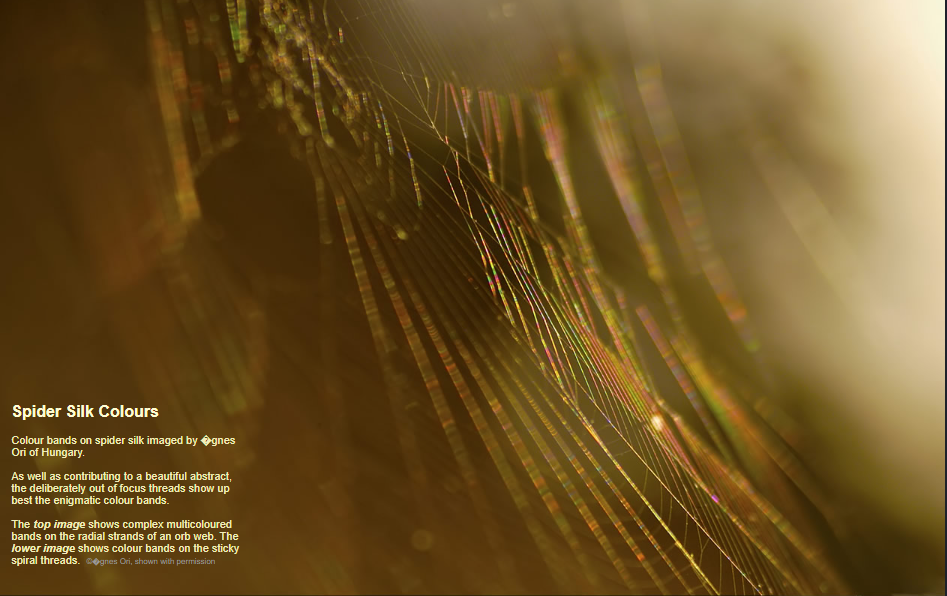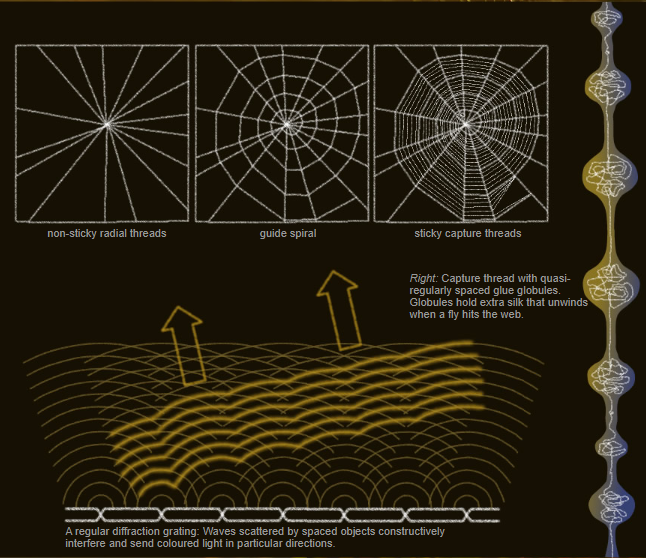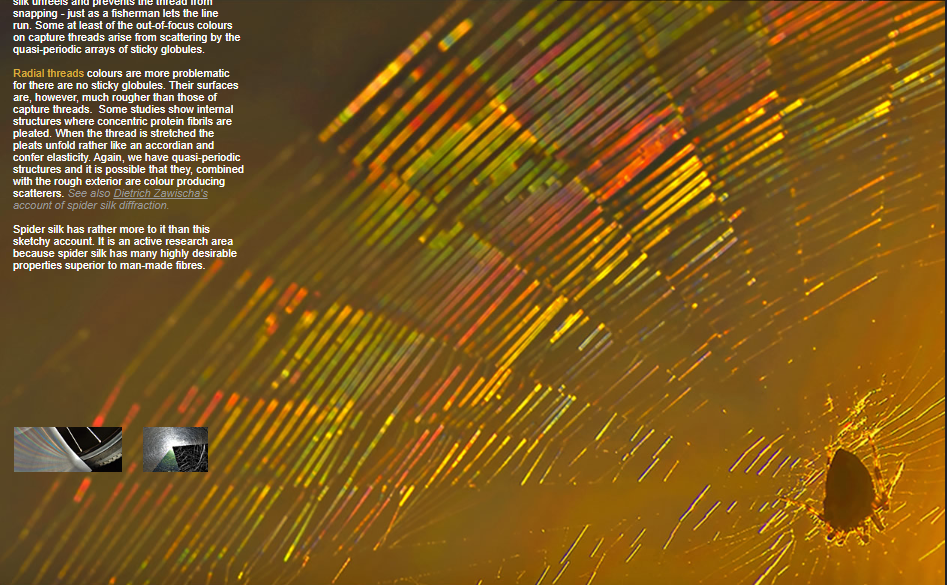OPOD - Spider Silk
OPOD - Spider Silk: Unveiling the Enigmatic Colors
Spider silk, a marvel of nature, not only serves as a structural element for webs but also exhibits mesmerizing colors. These colors can be observed in both radial and sticky spiral threads, adding a touch of abstract beauty to these intricate creations. When viewed from certain angles, spider silk reveals complex multicolored bands that captivate the eye and pique curiosity. Let's delve deeper into the phenomenon of spider silk colors and explore the fascinating mechanisms behind their appearance.
Iridescent Colors on "Dry" Webs
When observing "dry" spider webs, especially when illuminated by light, they can display iridescent colors that change rapidly along individual threads. This effect is best visualized in out-of-focus images, where the colors become more pronounced. Unlike the rainbow refraction glints seen when water droplets are present on dew-covered webs, the colors on "dry" webs arise from a different phenomenon known as diffraction.
Diffraction: The Key to Spider Silk Colors
Spider silk, with a diameter ranging from 1 to 5 microns, is comparable to the wavelengths of visible light (0.4 - 0.7 microns). When incident light waves interact with spider silk, they are scattered and combine to produce color-dependent interference. Unlike atmospheric interference effects such as a corona or glory, which result from scattering by individual droplets or particles, spider silk colors originate from quasi-periodic arrays of scattering centers.
Unraveling the Quasi-Periodic Structures
To understand the origins of spider silk colors, it is essential to examine the various thread types found in an orb web. The iridescent colors observed in spider silk primarily come from radial (non-sticky) threads and sticky capture threads. These threads possess unique properties that contribute to their optical effects.
Sticky Capture Threads: A Masterpiece of Engineering
Spiral capture threads are a testament to the remarkable engineering of spider silk. These threads are not only incredibly strong but also highly elastic and sticky. Advanced microscopy techniques, including optical, electron, and atomic force microscopy, have revealed that the silk's surface is smooth and coated with a viscous glue that accumulates into globules. The presence of these sticky globules allows the silk to maintain tension, preventing it from snapping when a prey strikes the web.
Radial Threads: Roughness and Internal Structures
In contrast to sticky capture threads, radial threads lack sticky globules. However, their surfaces are significantly rougher. Studies have shown the existence of internal structures within radial threads, consisting of concentric protein fibrils that are pleated. When these threads are stretched, the pleats unfold, conferring elasticity to the silk. It is hypothesized that the combination of these quasi-periodic structures and the rough exterior of radial threads contributes to their color-producing scattering properties.
The Intricacies of Spider Silk
Spider silk's captivating colors are just one aspect of its remarkable properties. This natural fiber continues to be an active area of research due to its numerous desirable qualities that surpass those of man-made fibers. Some of the notable characteristics of spider silk include:
- Exceptional strength: Spider silk is stronger than steel on a weight-to-strength basis.
- Elasticity: The ability of spider silk to stretch and recoil makes it ideal for capturing prey without breaking.
- Biocompatibility: Spider silk is biodegradable and biocompatible, making it suitable for various medical applications.
- Antibacterial properties: Certain species of spiders incorporate antimicrobial compounds into their silk, which can help prevent infections.
In Conclusion
Spider silk, with its enigmatic colors and extraordinary properties, continues to captivate scientists and enthusiasts alike. The interplay between diffraction and the quasi-periodic structures found within different types of spider silk threads gives rise to the vibrant hues observed. As research in this field progresses, we gain a deeper understanding of nature's ingenuity and unlock new possibilities for harnessing the remarkable properties of spider silk.

Spider Silk Colours
Colour bands on spider silk imaged by �gnes Ori of Hungary.
As well as contributing to a beautiful abstract, the deliberately out of focus threads show up best the enigmatic colour bands.
The top image shows complex multicoloured bands on the radial strands of an orb web. The lower image shows colour bands on the sticky spiral threads. ©�gnes Ori, shown with permission

View ‘dry’ spider webs, particularly towards the light and they can show iridescent colours. The colours often change rapidly along individual threads, an effect best seen in out-of-focus images.
Water drops on bedewed webs show rainbow refraction glints but the colours on 'dry' webs arise instead from diffraction. Spider silk is 1-5 micron diameter and comparable to the wavelengths of visible light, 0.4 – 0.7 micron. Incident light waves are scattered and combine to give colour dependent interference.
There is a difference from atmospheric interference effects like a corona or glory. Those are from scattering by individual droplets or particles. In contrast, spider silk colours shriek of generation by quasi-periodic arrays of scattering centres. A regular array would be a one-dimensional diffraction grating pictured at lower right. The grating produces colours because individual outgoing waves from its scattering elements constructively interfere only in specific directions.
What are the quasi-periodic structures? An orb web has several thread types. The ones pictured here showing iridescence are radial (non-sticky) threads and sticky capture threads.
Spiral capture threads are engineering marvels. The silk is very strong. To withstand the impact of large flies it must also be very elastic. And it must be sticky. A combination of optical, electron and atomic force microscopy show that the silk has a smooth surface and is coated with a viscous glue which mostly accumulates (by surface tension forces) into globules. Large globules usually have a smaller one between them.
The silk gathers inside the globules and thus keeps the thread taut. When a fly strikes the silk unreels and prevents the thread from snapping - just as a fisherman lets the line run. Some at least of the out-of-focus colours on capture threads arise from scattering by the quasi-periodic arrays of sticky globules.
Radial threads colours are more problematic for there are no sticky globules. Their surfaces are, however, much rougher than those of capture threads. Some studies show internal structures where concentric protein fibrils are pleated. When the thread is stretched the pleats unfold rather like an accordian and confer elasticity. Again, we have quasi-periodic structures and it is possible that they, combined with the rough exterior are colour producing scatterers. See also Dietrich Zawischa's account of spider silk diffraction.
Spider silk has rather more to it than this sketchy account. It is an active research area because spider silk has many highly desirable properties superior to man-made fibres.

Note: this article has been automatically converted from the old site and may not appear as intended. You can find the original article here.
Reference Atmospheric Optics
If you use any of the definitions, information, or data presented on Atmospheric Optics, please copy the link or reference below to properly credit us as the reference source. Thank you!
-
<a href="https://atoptics.co.uk/blog/opod-spider-silk/">OPOD - Spider Silk</a>
-
"OPOD - Spider Silk". Atmospheric Optics. Accessed on July 27, 2024. https://atoptics.co.uk/blog/opod-spider-silk/.
-
"OPOD - Spider Silk". Atmospheric Optics, https://atoptics.co.uk/blog/opod-spider-silk/. Accessed 27 July, 2024
-
OPOD - Spider Silk. Atmospheric Optics. Retrieved from https://atoptics.co.uk/blog/opod-spider-silk/.